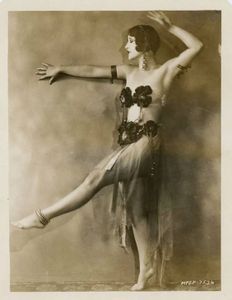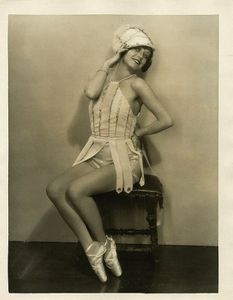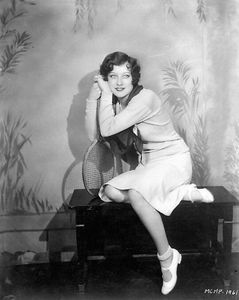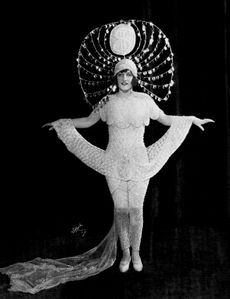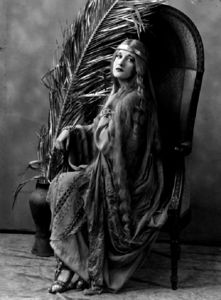Joan Crawford
| Joan Crawford | ||
 | ||
| Background information | ||
| Born as: | Lucille Fay LeSueur | |
| Born | March 23, c. 190? (uncertain) San Antonio, Texas, U.S. | |
| Died | May 10, 1977 Manhattan, New York City, New York, U.S. | |
| Buried: | Ferncliff Cemetery, Hartsdale, New York, U.S. | |
| Spouse(s): |
| |
| Children: | 4, including Christina Crawford | |
| Relatives: | Hal LeSueur (brother) | |
| Occupation: | Film and television actress, dancer, business executive | |
Joan Crawford (born Lucille Fay LeSueur; ✦March 23, c. 1904-1908 – †May 10, 1977) was an American actress. Starting as a dancer in traveling theatrical companies before debuting on Broadway, Crawford was signed to a motion picture contract by Metro-Goldwyn-Mayer in 1925. Initially frustrated by the size and quality of her parts, Crawford began a campaign of self-publicity and became nationally-known as a flapper by the end of the 1920s. In the 1930s, Crawford's fame rivaled MGM colleagues Norma Shearer and Greta Garbo. Crawford often played hardworking young women who find romance and financial success. These "rags-to-riches" stories were well received by Depression-era audiences and were popular with women. Crawford became one of Hollywood's most prominent movie stars and one of the highest-paid women in the United States, but her films began losing money and by the end of the 1930s she was labeled "box office poison".
After an absence of nearly two years from the screen, Crawford staged a comeback by starring in Mildred Pierce (1945), for which she won the Academy Award for Best Actress. In 1955, she became involved with the Pepsi-Cola Company, through her marriage to Coca-Cola company president Alfred Steele. After his death in 1959, Crawford was elected to fill his vacancy on the board of directors but was forcibly retired in 1973. She continued acting in film and television regularly through the 1960s when her performances became fewer; after the release of the horror film Trog in 1970, Crawford retired from the screen. Following a public appearance in 1974, after which unflattering photographs were published, Crawford withdrew from public life. She became more and more reclusive until her death in 1977.
Crawford married four times. Her first three marriages ended in divorce; the last ended with the death of her husband Al Steele. She adopted five children, one of whom was reclaimed by his birth mother. Crawford's relationships with her two older children, Christina and Christopher, were acrimonious. Crawford disinherited the two and, after Crawford's death, Christina wrote a "tell-all" memoir called Mommie Dearest.
Early life
Born Lucille Fay LeSueur, of French-Huguenot, English, Dutch, and Irish ancestry in San Antonio, Texas, she was the second of the two children of Thomas E. LeSueur (born January 2, 1867, in Tennessee; died January 1, 1938), a construction worker, and Anna Bell Johnson (born November 29, 1884, in Texas; died August 15, 1958), and later Mrs. Anna Cassin. She apparently was still under 20 when her first two children were born. Crawford had one sister, Daisy, and one brother Hal LeSueur.
Thomas LeSueur abandoned the family when Lucille was ten months old, eventually resettling in Abilene, Texas, reportedly working in construction. Crawford's mother married Henry J. Cassin; this marriage is listed in the census as her first. They lived in Lawton, Oklahoma, where Cassin ran the Ramsey Opera House, booking such diverse and noted performers as Anna Pavlova and Eva Tanguay. As a child, Crawford, who preferred the nickname "Billie", enjoyed watching vaudeville acts perform on the stage of her stepfather's theatre. At that time, Crawford was reportedly unaware that Cassin, whom she called "Daddy", was not her biological father; her brother later told her the truth. Cassin allegedly began sexually abusing her when she was eleven and continued until she was sent to St. Agnes Academy, a Catholic girls' school.
From childhood, Crawford's ambition was to be a dancer. One day, in an attempt to escape piano lessons, she leaped from the front porch of her home and cut her foot severely on a broken milk bottle. She had three surgeries to repair the damage and for 18 months was unable to attend elementary school or continue dancing lessons.
In June 1917, the family moved to Kansas City, Missouri, after Cassin was accused of embezzlement; although acquitted, he was blacklisted in Lawton. After the move, Cassin, a Catholic, placed Crawford at St. Agnes Academy, in Kansas City. When her mother and stepfather separated, she remained at school as a working student, where she spent far more time working, primarily cooking and cleaning, than studying. She later attended Rockingham Academy, also as a working student. While there, she began dating, and had her first serious relationship, with a trumpet player, Ray Sterling, who reportedly inspired her to challenge herself academically.
In 1922, she registered at Stephens College, in Columbia, Missouri, giving her year of birth as 1906. She attended Stephens for a few months and then withdrew after she realized that she was not ready for college. Because of her family's instability, Crawford's schooling never surpassed the primary level.
Self-promotion, and early successes
Growing increasingly frustrated over the size and quality of the parts she was given, Crawford embarked on a campaign of self-promotion. As MGM screenwriter Frederica Sagor Maas recalled, "No one decided to make Joan Crawford a star. Joan Crawford became a star because Joan Crawford decided to become a star." She began attending dances in the afternoons and evenings at hotels around Hollywood and at dance venues on the beach piers, where she often won dance competitions with her performances of the Charleston and the Black Bottom.
Her strategy worked and MGM cast her in the film where she first made an impression on audiences, Edmund Goulding's Sally, Irene and Mary (1925). From the beginning of her career, Crawford considered Norma Shearer – the studio's most-popular actress – her professional nemesis. Shearer was married to MGM Head of Production Irving Thalberg; hence, she had the first choice of scripts, and had more control than other stars in what films she would and would not make. Crawford was quoted to have said: "How can I compete with Norma? She sleeps with the boss!"
Crawford was named one of 1926's WAMPAS Baby Stars, along with Mary Astor, Dolores del Río, Janet Gaynor, and Fay Wray, among others. That same year, she co-starred in Paris with Charles Ray. Within a few years, she became the romantic lead to many of MGM's top male stars, including Ramón Novarro, John Gilbert, William Haines, and Tim McCoy.
Crawford appeared as a skimpily-clad young carnival assistant in The Unknown (1927), starring Lon Chaney, Sr. as a carnival knife thrower with no arms who hopes to marry her. She stated that she learned more about acting from watching Chaney work than from anyone else in her career. "It was then", she said, "I became aware for the first time of the difference between standing in front of a camera, and acting." Also in 1927, she appeared alongside her close friend, William Haines, in Spring Fever, which was the first of three movies the duo made together.
In 1928, Crawford starred opposite Ramón Novarro in Across to Singapore, but it was her role as Diana Medford in Our Dancing Daughters (1928) that catapulted her to stardom. The role established her as a symbol of modern 1920s-style femininity which rivaled Clara Bow, the original "It girl ", and Hollywood's foremost flapper. A stream of hits followed Our Dancing Daughters, including two more flapper-themed movies, in which Crawford embodied for her legion of fans (many of whom were women) an idealized vision of the free-spirited, all-American girl.
F. Scott Fitzgerald wrote of Crawford:
- Joan Crawford is doubtless the best example of the flapper, the girl you see in smart nightclubs, gowned to the apex of sophistication, toying iced glasses with a remote, faintly bitter expression, dancing deliciously, laughing a great deal, with wide, hurt eyes. Young things with a talent for living.
Crawford described her glamorous onscreen persona more succinctly, saying, "If you want to see the girl next door, go next door."
On June 3, 1929, Crawford married Douglas Fairbanks Jr. at Saint Malachy's Roman Catholic Church (known as "The Actors' Chapel", owing to its proximity to Broadway theatres) in Manhattan, although neither was Catholic. Fairbanks was the son of Douglas Fairbanks Sr and the stepson of Mary Pickford, who were considered Hollywood royalty. Fairbanks, Sr., and Pickford were opposed to the marriage and did not invite the couple to their home at Pickfair for eight months after the marriage.
The relationship between Crawford and Fairbanks, Sr., eventually warmed; she called him Uncle Doug, and he called her Billie, her childhood nickname, but one that close friends used throughout her life.[45] She and Pickford, however, continued to despise each other. Following that first invitation, Crawford and Fairbanks, Jr., became more frequent guests. While the Fairbanks men played golf together, Crawford was either left with Pickford, who would retire to her quarters, or simply left alone.
To rid herself of her Southwestern accent, Crawford tirelessly practiced diction and elocution. She said:
- If I were to speak lines, it would be a good idea, I thought, to read aloud to myself, listen carefully to my voice quality and enunciation, and try to learn in that manner. I would lock myself in my room and read newspapers, magazines and books aloud. At my elbow, I kept a dictionary. When I came to a word I did not know how to pronounce, I looked it up and repeated it correctly fifteen times.
Move to Warner Bros.
For $500,000, Crawford signed with Warner Bros. for a three-movie deal and was placed on the payroll on July 1, 1943. Her first film for the studio was Hollywood Canteen (1944), an all-star morale-booster film that teamed her with several other top movie stars at the time. Crawford said one of the main reasons she signed with Warner Bros. was because she wanted to play the character "Mattie" in a proposed 1944 film version of Edith Wharton's novel Ethan Frome (1911).
Death and legacy
On May 6, 1977, Crawford gave away her Shih Tzu, 'Princess Lotus Blossom', because she was too weak to continue to care for her. Crawford died on May 10, 1977, at her apartment in Lenox Hill, New York City, of myocardial infarction (heart attack). A funeral was held at Campbell Funeral Home, New York, on May 13, 1977. In her will, which was signed on October 28, 1976, Crawford bequeathed to her two youngest children, Cindy and Cathy, $77,500 each from her $2 million estate.
She explicitly disinherited the two eldest, Christina and Christopher: "It is my intention to make no provision herein for my son, Christopher, or my daughter, Christina, for reasons which are well known to them." Both of them challenged the will and received a $55,000 settlement. She also bequeathed nothing to her niece, Joan Lowe (1933–1999; born Joan Crawford LeSueur, the only child of her estranged brother, Hal). Crawford left money to her favorite charities: the USO of New York, the Motion Picture & Television Country House and Hospital, the American Cancer Society, the Muscular Dystrophy Association, the American Heart Association, and the Wiltwyck School for Boys. During World War II, she was a member of American Women's Voluntary Services.
A memorial service was held for Crawford at All Souls' Unitarian Church on Lexington Avenue in New York on May 16, 1977. In attendance were long-time friend Myrna Loy and co-stars Geraldine Brooks and Cliff Robertson, who gave eulogies; Pearl Bailey sang "He'll Understand". Another memorial service, organized by George Cukor, was held on June 24 in the Samuel Goldwyn Theater at the Academy of Motion Picture Arts and Sciences in Beverly Hills, California. Crawford was cremated, and her ashes placed in a crypt with her fourth and final husband, Alfred Steele, in Ferncliff Cemetery, Hartsdale, New York.
Joan Crawford's handprints and footprints are immortalized in the forecourt of Grauman's Chinese Theatre in Hollywood. She has a star on the Hollywood Walk of Fame, at 1752 Vine Street, for her contributions to the motion picture industry. Playboy listed Crawford as #84 of the "100 Sexiest Women of the 20th century". In 1999, Crawford was also voted the tenth greatest female star of the Classic American cinema by the American Film Institute.
Crawford has also attracted a following in the gay community. In Joan Crawford: The Essential Biography, the author believes that Crawford appeals to many gay men because they sympathize with her struggle for success in both the entertainment industry and her personal life.
- Wikipedia article: Joan Crawford
| Note: Joan Crawford was a volunteer at the Hollywood Canteen |
External links
Chat rooms • What links here • Copyright info • Contact information • Category:Root
